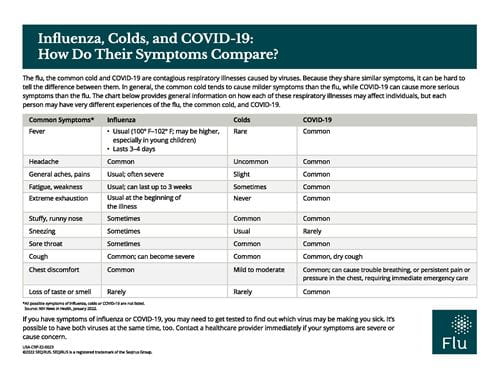Learn how flu symptoms compare to symptoms of other common illnesses
In any given year, there’s a decent chance any of us might catch the flu: The Centers for Disease Control and Prevention (CDC) suggests that on average, about 8% of the U.S. population will have it during each flu season.Recognizing influenza symptoms may be a little challenging, as the flu can cause some symptoms similar to the common cold and COVID-19. Getting familiar with the effects of the flu as well as these other illnesses may help you in your recovery—and take steps to stop the spread of infectious disease. If you have symptoms that lead you to think you might have the flu or another infectious disease, make sure you get examined by your healthcare provider.
Flu symptoms often start suddenly
People with influenza usually start feeling symptoms about 2 days after becoming infected. However, they may begin to feel symptoms as soon as one day after exposure—or even up to 4 days after.
Some common flu symptoms include:
- Achy muscles or body aches
- Cough
- Fatigue or feeling tired
- Fever or feeling feverish/chills (may not apply to all people with flu)
- Headaches
- Runny or stuffed-up nose
- Sore throat
Some people may vomit or have diarrhea when they have influenza. This tends to happen more frequently in children than in others.
For many people, influenza is something that might knock them down with some mild symptoms lasting from a few days up to about 2 weeks before feeling better again.
Yet the flu can also cause more serious illness: some people can experience complications and even death. Sinus and ear infections are a couple of the complications that may occur in people with flu; pneumonia or inflammation of different organs are some of the more serious complications. Flu may also worsen some pre-existing chronic medical issues that someone may have.
Flu and the common cold
Some of the symptoms typical of flu are also typical of colds, which people catch through other viruses. In general, unlike influenza, cold symptoms tend to start gradually and be milder in nature, causing people to have a runny or stuffy nose more often than the flu does. Colds rarely cause fever or headache; they also do not typically cause serious complications, as influenza can.
Flu and COVID-19
Both influenza and COVID-19 share many symptoms, as well (notably, changes in taste or smell occurs with greater frequency with COVID-19). COVID-19 can take longer than the flu before symptoms become apparent, and it may also cause more serious health issues in some people, such as blood clots in veins and arteries, and multisystem inflammatory syndrome in children and adults.
Keeping the symptoms for each of these illnesses top of mind over time can be a challenge. Download our comparison chart as a handy reference when you need a quick refresher on flu, cold and COVID-19 symptoms. Remember, your healthcare provider will be best able to assess your symptoms.





